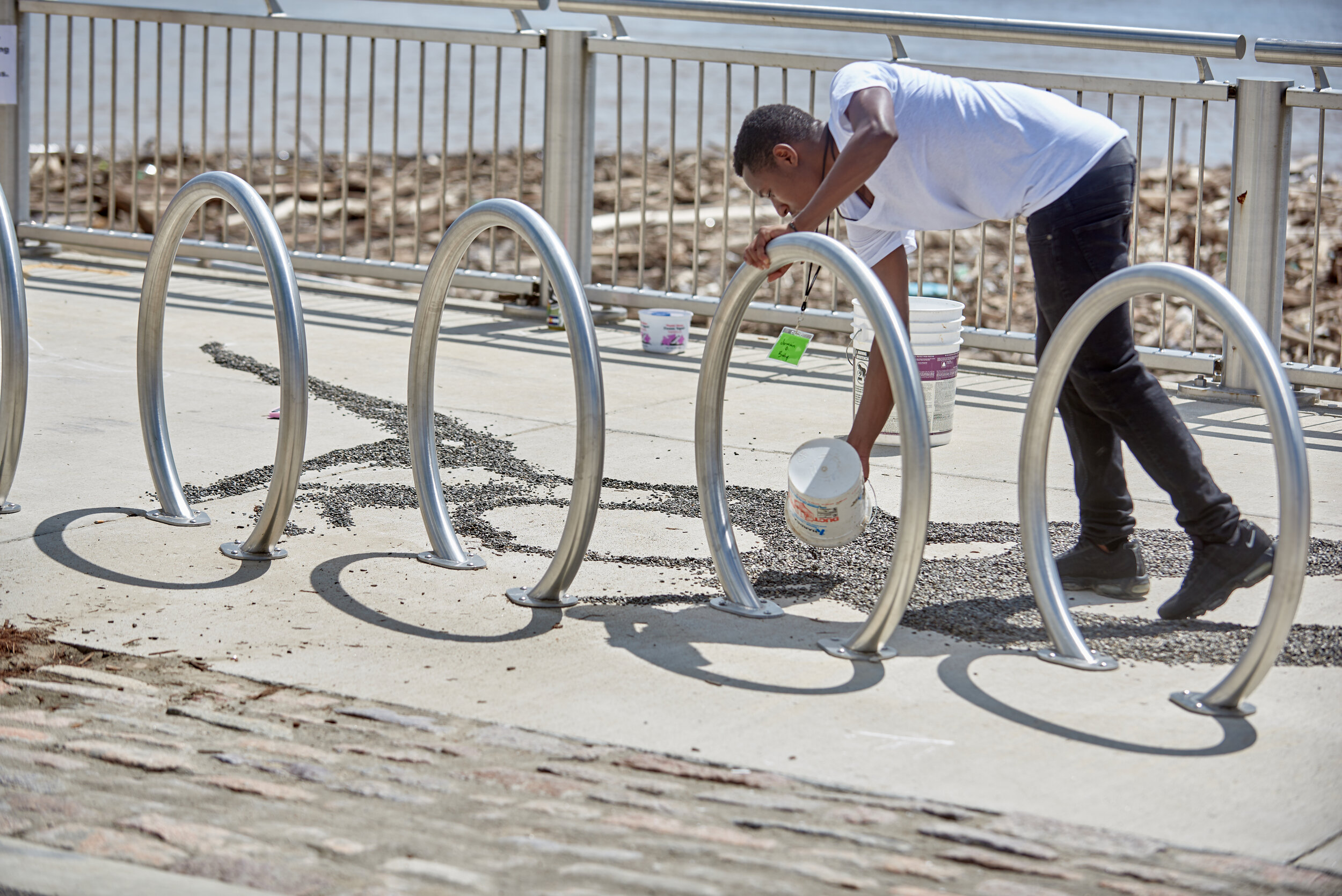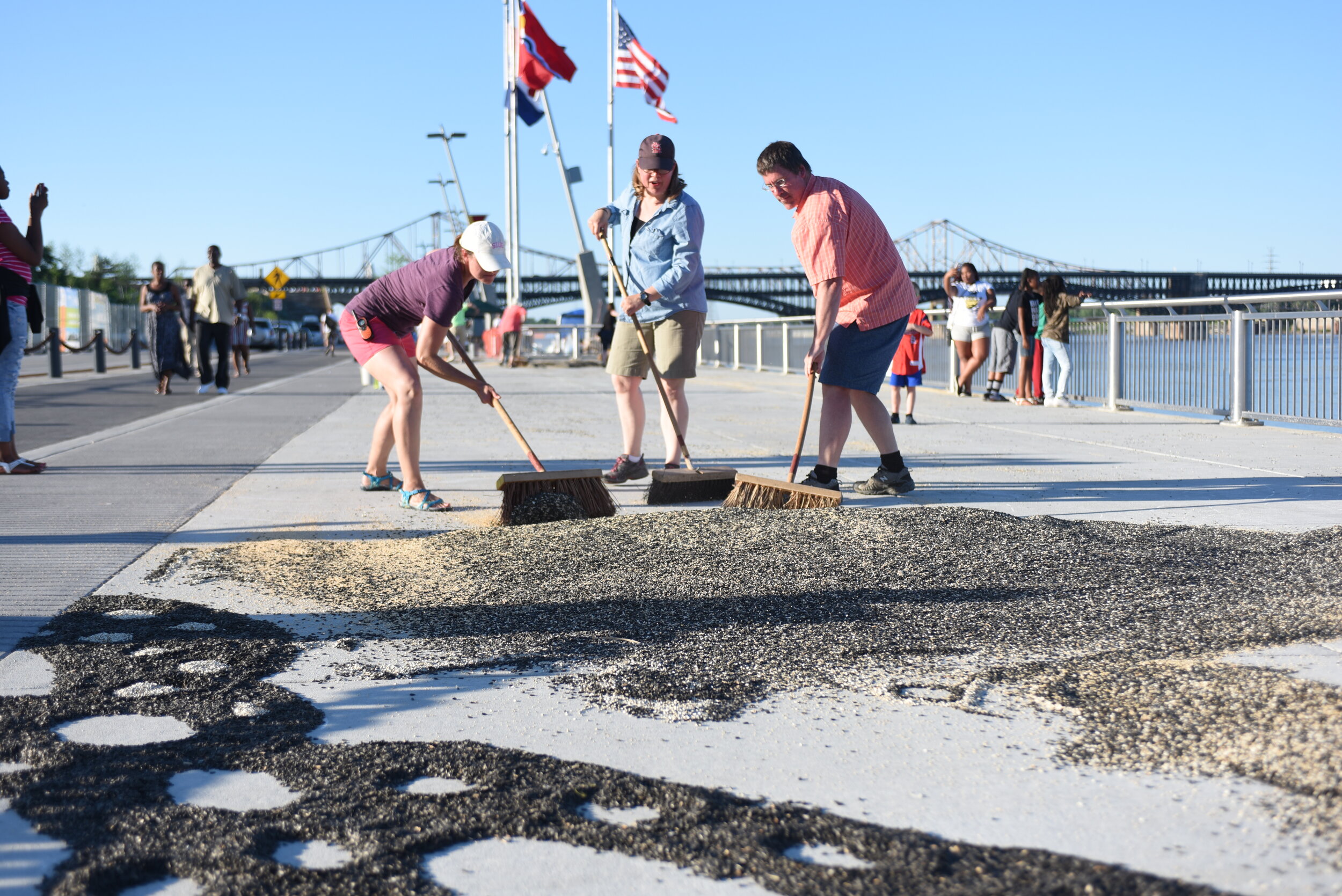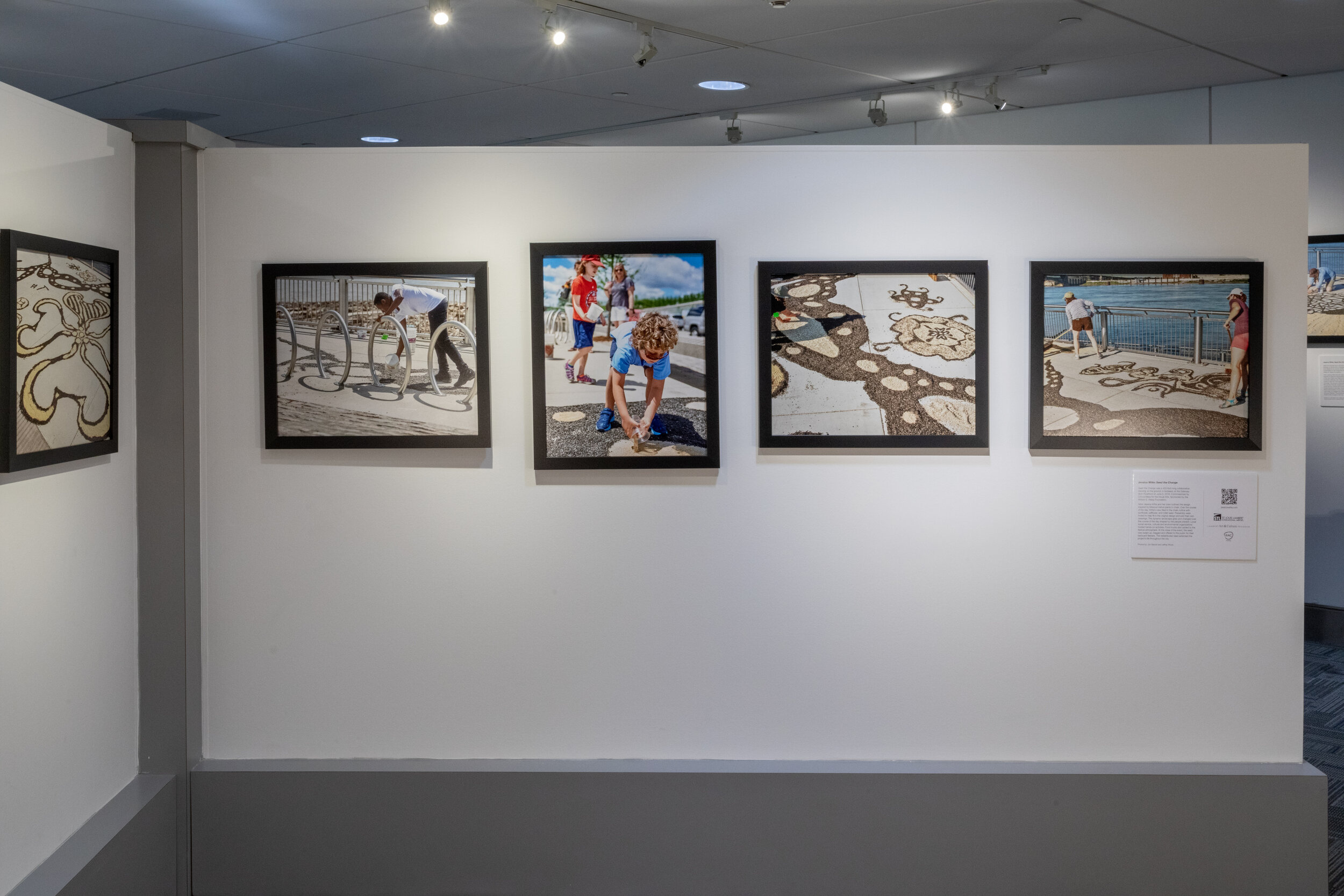All images from the exhibition with captions.

Native Missouri plants, including the coneflower, were the inspiration for the original pattern that covered the walkway below the Gateway Arch. Artist Jessica Witte, her crew and the public used one-and-a-half tons of birdseed to craft awe-inspiring drawings that shifted and grew as the day progressed.

The public played a large part in the evolution of Seed the Change throughout the day. The artist encouraged passers-by, including this family of six, to create their own pictures using birdseed along the promenade. The welcomed additions intermingled with the artist’s initial 420-foot design.

A visitor meanders around the edge of a drawing of a dogwood flower. All of the drawings were created out of birdseed directly on the ground. The images shifted throughout the daylong event and the birdseed was swept up and donated at the end.

The very nature and beauty of the massive collaboration was that everyone in attendance was encouraged to add to it, embellish it or make their own creation among the original designs. If anyone disturbed a design, it just added to the dynamic landscape.

The canvas for Seed the Change was Leonor K. Sullivan Boulevard, flanked by the iconic Gateway Arch and Mississippi River. The massive artwork helped kick off the opening weekend for the newly designed riverfront on June 5, 2016. Environmental, cultural and social organizations hosted hands-on activities for visitors and food trucks added to the festival-like atmosphere.

Passers-by were invited to grab handfuls of seed from buckets along the sidewalk. Here a bucket sits at the center of a dogwood flower outline. The dogwood was originally sketched in chalk along the walk and the seeds placed on top of it by art ambassadors.

Native Missouri plants inspired artist Jessica Witte’s underlying designs, such as this coneflower, for Seed the Change. The temporary artwork made entirely out of birdseed was meant to morph throughout the day and temporarily transform the walkway. At day’s end, it was swept away.

Seed the Change began the morning of June 5, 2016, with 3,000 pounds of birdseed arriving along the promenade below the towering Gateway Arch. The artist chose sunflower, safflower and millet seeds as her medium because it was environmentally-friendly and non-toxic. Seed is also a metaphor for potential and growth.

Young artists flexed their creative muscles and spent time carefully shaping their own additions to Seed the Change. The massive artwork grew in size and scope throughout the day as artists of all ages added their own special touches.

Artist and Seed the Change creator Jessica Witte worked diligently on the center dogwood pattern. Her goal for the project was “to highlight the city’s human potential; creating a welcoming space shaped by its people that embodies the beauty of labors of love, conversation and individual expression.”

Two of the day’s visitors crouched down and got lost in the creative process while working with seeds.

The artist’s crew worked through the day to ensure Witte’s planned designs would be outlined in seed and highly visible. Walkers on the riverfront were encouraged to help the team outline the chalk lines or add their own designs. One of Witte’s favorite additions was the little clown fish (top center) using all three types of seed.

The planned design by Witte carefully lined up the artwork with tree planters and other features already along the riverfront walkway. The Hawthorn blossom depicted here is the state flower of Missouri.

A young boy designed a whale using a mix of millet, safflower and sunflower seeds. He used a cup to help pour the seeds into his outline as part of the public art project Seed the Change.

Witte’s team fills in the coneflower’s petals with millet, while young families concentrate on their own seed drawings. The seed drawing would grow and change over the course of the day, shaped by the crowd that gathered on the promenade.

As the day progresses, the original design by Witte filled with stripes, symbols and names the crowd added that day. The temporary nature of the project meant one needed to take action immediately to add their signature. Artist Witte’s aim was to inspire the crowd to see their own creative potential.

A Seed the Change art ambassador builds the design in seed around a bike rack along the promenade. Art ambassadors were hired to help fill in the seed drawing and invite the public to join over the span of the 9-hour public art event.

Two young children make and move around piles of seeds as they have fun adding to the constantly-changing silhouette. The event was family friendly and gave visitors to Gateway Arch National Park a unique experience.

The sun casts a deep shadow as a volunteer filled in a Hawthorn flower embellishment on the sidewalk near star-like shapes added by the crowd. Footprints from passers-by can be seen in the deep piles of seeds, which added to the changing nature of the art project as the day progressed.

The crowd’s additions to the walkway made the art project even more dynamic. A pattern sculpted by a passer-by enlivened an area close to the water. Near day’s end, volunteers get ready to sweep away the picture to return the promenade to its original blank slate.

A volunteer helps fill in the 420-foot drawing on the Riverfront. More than 30 volunteers, 11 Art Ambassadors, and a Site Manager helped artist Jessica Witte make the day-long festival a success.

Tents hosted by COCA (Center for Creative Arts) and Missouri Botanical Gardens offer shade and hands-on activities for visitors in this view looking south along the Mississippi River. The St. Louis Arc, St. Louis Audubon Society, Gateway Greening, Grow Native!, BioDiverseCity St. Louis Network and the EarthDance Organic Farm School also engaged with the audience.

Children roll clay and wildflower seeds into “seed bombs” at Missouri Botanical Gardens Tent. At the COCA tent, visitors decorated bags to take birdseed home with them. These hands-on activities, picnic tables, and food trucks helped make a festival-like atmosphere.

Shapes, words and names fill in the spaces between Witte’s original design in this view looking north near the end of day. As the afternoon progressed, the shadow of the Arch and a few tents with picnic tables provided shade for those exploring the waterfront and Seed the Change drawing.

At the end of the day, volunteers swept up the seeds along the promenade. The 420-foot drawing was created, enjoyed and dismantled within nine hours.

A volunteer helps “erase” the massive drawing. BrightSide St. Louis donated bags and loaned brooms and bins to clean up and distribute the seed. The artist’s crew swept, collected and re-bagged the used birdseed and offered it to visitors to take home for their bird feeders, letting a portion of the event live on throughout the city.

“Erasing” the drawing was just as important as creating it. The artist wanted to leave the space as she found it, so choosing an ecologically low-impact medium was crucial.

As the sun goes down at the riverfront, the crew placed seeds into bags for distribution. Seeds were offered to those in attendance and the rest donated to the World Bird Sanctuary.

A Missouri Botanical Gardens volunteer demonstrating how to make seed bombs with young visitors. Seed bombs were made by rolling wildflower seed inside clay balls to take home and plant.

Photographer Jeffrey Bruce captures a section of the seed drawing based on the hawthorn flower. This small tree’s blooms have five irregular shaped petals and are Missouri’s state flower.

A volunteers helps explain the project and brings seed and tools to an Arch visitor (right). The artist’s crew worked throughout the day to ensure Witte’s 420 -foot-design would be outlined in seed and highly visible. Art Ambassadors were hired to invite the public to participate and add to the original design.

A volunteer and her son puts finishing touches on the coneflower design. The artist Jessica Witte selected three Missouri native plants the coneflower, hawthorn, and dogwood because they thrive in and beautify the St. Louis region.


















































